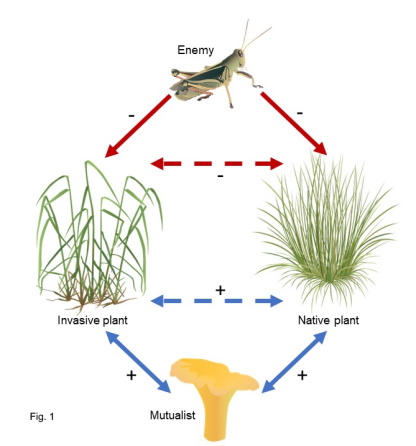18 June 2021
 How does the introduction of non-native species affect interactions between native plants, animals, and microbes?
How does the introduction of non-native species affect interactions between native plants, animals, and microbes?
A long-running Bio-Protection Research Centre project has been investigating how plant invasions change existing ecological interactions – and lead to new ones. Some of the results have been surprising.
Just as human social interactions define who we are, species are defined by their network of ecological interactions. But humans have disrupted these networks by introducing non-native species both deliberately and accidentally.
Many non-native species occur at high densities, suggesting that they have diverse and strong indirect biotic interactions with the surrounding community that are mediated by direct interaction partners (see examples in Fig. 1, below). Yet we do not really understand how these indirect interactions contribute to non-native species’ success and impacts.
The BPRC’s Project 6 has approached this knowledge gap from multiple angles. Researchers have:
- Conducted literature reviews on species interactions and plant invasions (Dickie et al., 2017, Allen, 2020).
- Carried out field experiments investigating the microbial associations and indirect impacts of invasive Scotch broom (Cytisus scoparius) (Allen et al., 2020, Wainer et al., in preparation).
- Applied next-generation molecular techniques to understand pathogen and insect communities in landscapes dominated by non-native plants (Makiola et al., 2019, Makiola et al., in preparation, Marion et al., submitted).
- Completed an ambitious mesocosm experiment that examined community- and ecosystem-level causes and consequences of plant invasions (Waller et al., 2020; Allen et al., revisions requested; Waller et al., in preparation).
Contrary to the prevailing theory that non-native species should have weaker interactions than native species, we showed that non-native plants can host many interacting species. Furthermore, these species tend to be highly generalist, also interacting with many others. For example, non-native plants in our experimental mesocosm plant communities supported higher herbivore diversity and biomass, and higher relative abundance of fungal pathogens, than did native plants. Similarly, Scotch broom invasion increased fungal diversity in a field survey at Molesworth Station.
These findings imply that non-native plants should participate in strong indirect biotic interactions with the surrounding community (Fig. 1). We found mixed support for this hypothesis. For example, a field experiment at Brooksdale Station showed that invasive Scotch broom indirectly benefitted both native and non-native plant species via beneficial soil fungi and reduced hare browsing. However, these indirect interactions were stronger for non-native plants, suggesting that they may lead to secondary plant invasions.
In the mesocosm experiment, non-native plants were more affected by herbivory than were native plants. However, the non-native plants consistently dominated community biomass because of their fast growth rates and strong indirect impacts (i.e., they supported herbivores and pathogens that attacked other species) on the neighbouring community.
Taken together, these results challenge the prevailing hypothesis that invasive plants are successful because they escape natural enemies compared with co-occurring native species. Instead, non-native plants can accumulate a generalist community of enemies and mutualists and help to spread these interactions to co-occurring native and non-native species.
What does this mean from an applied perspective? Our research suggests that management of invasive plants could more widely incorporate these indirect biotic interactions. For example, management practices that target indirect interaction partners rather than the focal invader may provide new ways to mitigate invasion impacts. Additionally, understanding indirect interactions could help scientists to predict unanticipated impacts of potential future invaders, as well as unanticipated impacts of removing them from invaded ecosystems.

Indirect interactions between non-native and native plants mediated by shared enemies (e.g., herbivores, pathogens) or mutualists (e.g., pollinators, mycorrhizal fungi). Solid and dashed arrows represent direct and indirect interactions, respectively. Arrow colours represent negative (red) and positive (blue) interactions. Plant and insect symbols modified from Tracey Saxby, freely available from IAN Image Library (ian.umces.edu/imagelibrary/).
References
Allen WJ (2020) Indirect biotic interactions between non-native plants and native plants and animals. In: Traveset A, Richardson DM (eds.), Plant Invasions: The Role of Species Interactions. CABI Publishing.
Allen WJ, Wainer R, Shadbolt M-W, Tylianakis JM, Barratt BIP, Waller LP, Dickie IA (2020) Community-level direct and indirect impacts of an invasive plant favour exotic over native species. Journal of Ecology 108: 2499-2510.
Allen WJ, Waller LP, Barratt BIP, Dickie IA, Tylianakis JM (revisions requested) Exotic plants accumulate and share generalist herbivores but still dominate communities via rapid growth. Nature Communications.
Dickie IA, Bufford JL, Cobb RC, Desprez‐Loustau ML, Grelet G, Hulme PE, Klironomos J, Makiola A, Nuñez MA, Pringle A, Thrall PH (2017) The emerging science of linked plant–fungal invasions. New Phytologist 215: 1314-1332.
Makiola A, Dickie IA, Holdaway RJ, Wood JR, Orwin KH, Glare TR (2019) Land use is a determinant of plant pathogen alpha‐but not beta‐diversity. Molecular Ecology 28: 3786-3798.
Makiola A, Holdaway RJ, Wood JR, Orwin KH, Glare TR, Dickie IA (in preparation) Environmental drivers of plant pathogen community composition and richness. For New Phytologist.
Marion Z, Orwin K, Wood JR, Holdaway RJ, Dickie IA (submitted) Land-use but not distance drives fungal beta diversity. Submitted to Ecology.
Wainer R, Ridgway HJ, Jones EI, Peltzer DA, Dickie IA (in preparation) The response of fungal communities to Cytisus scoparius invasion. For Fungal Ecology.
Waller LP, Allen WJ, Barratt BIP, Condron LM, França FM, Hunt JE, Koele N, Orwin KH, Steel G, Tylianakis JM, Wakelin S, Dickie IA (2020) Biotic interactions drive ecosystem responses to plant invaders. Science 368: 967-972.
Waller LP, Allen WJ, Black A, Tonkin J, Tylianakis JM, Wakelin A, Dickie IA (in preparation) Exotic plants accumulate generalist pathogens but escape from harm. For Ecology Letters.
